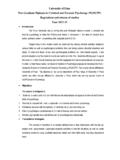Transcription of Offender Characteristics: The Constructs of Motives ...
1 8 Offender Characteristics: THE Constructs OF Motives ,PERSONALITY, AND BEHAVIORAs articulated in chapter 7, crime scene evidence is likely to be theonly data that a profiling investigator will have to work with when attemptingto solve a crime . From these data, the investigator will have to makepredictions about the characteristics of an unidentified perpetrator. In con-sidering how to relate pieces of crime scene evidence to Offender characteris-tics within a scientific model of profiling, the direction of causality is likelyto be the reverse of the profiling process as conducted in the field. That is,rather than positing that Offender characteristics are caused by the piecesof evidence that are left at a crime scene , a scientific profiling model positsthat it is an Offender 's characteristics that lead him to leave particular piecesand patterns of evidence during the commission of his crimes.
2 Therefore,the goal of profiling research on Offender characteristics is to empiricallyexamine on a large scale the kinds of Offender characteristics that are likelyto result in particular pieces or patterns of evidence. Taken together, theseoffender characteristics constitute three main categories: motive, personality,and date, no such large-scale study on Offender characteristics has beenundertaken. What would be required for this endeavor would be a systematicassessment of a national sample of solved cases, examining the crime scene157evidence and the categories of Offender characteristics just described, across awide variety of crime types and offenders. As can be imagined, the investmentrequired for a large-scale profiling research project would be significant interms of costs, personnel, and time. However, given the appropriate approvaland funding, the data are available for study.
3 The storehouse of case informa-tion across federal, state, and local law enforcement agencies is likely tobe information on crime scene evidence and Offender characteristicsfrom a variety of sources, path models (Duncan, 1966; Werts 6k Linn,1970) could be constructed and analyzed to determine the various pathwaysbetween Offender characteristics and pieces or patterns of crime scene evi-dence. Chapter 11 discusses the methods involved in path analysis in moredetail; in general, this technique allows researchers to estimate the magnitudeof the direct and indirect links between multiple variables and use thoseestimates to elucidate underlying causal processes (Asher, 1983). As dis-cussed in the following sections, the Offender characteristics of interest toprofiling consist of both observed and latent ( , unobserved) analytic tool that will be used in a scientific model of profiling mustaccommodate both types of Constructs to provide a complete picture ofimportant causal pathways.
4 Path analysis would be well suited for this taskbecause it considers both these observed and latent the absence of information and analyses from such a large-scaleresearch project, and with the hope that this book will facilitate such work,this chapter, chapter 9, and chapter 10 describe the components involvedin examining Offender characteristics and their relationships to crime sceneevidence. This chapter describes the Constructs of motive, personality, andbehavior and discusses their relationship to a science of profiling. Chap-ters 9 and 10 discuss the relationships between motive and personality,respectively, to behavior and crime scene evidence. Examples from thecriminological and psychological literature on offenders is provided in chap-ters 9 and 10 to illustrate how the categories of Offender characteristicsmight interact and how findings from the extant literature might inform amore comprehensive science of profiling.
5 Although the current offenderliterature consists of research conducted on a limited scale, it does provideclues for the study of Offender Motives , personality, and behavior and providesindicators of what scientists might find in a larger scale construct of motive is concerned with the question of why aperson engages in a behavior. The consideration of motive in profiling isbased on an assumption that crimes are committed purposefully and that158 CRIMINAL PROFILINGthe Motives behind the commission of an offense can be readily discernedand used to infer other Offender characteristics . Thus, discussions of motivehave been pervasive in the profiling literature ( , Canter, 2000; Douglas,Ressler, Burgess, & Hartman, 1986; Holmes & Holmes, 1996; Turvey, 1999),with regard to both inferring Motives from crime scene evidence ( ,Douglas, Burgess, Burgess, & Ressler, 1992) and inferring other offendercharacteristics from Motives ( , Canter & Fritzon, 1998).
6 Motive can bedefined in reference to three conceptual distinctions: motive versus intent,the existence of a motive versus the ability of scientists to discern it, andthe relationship of a motive to a criminal , although it is recognized that intent and motive are related,the two terms must be distinguished. Intent refers to whether an offenderpurposefully committed a criminal act, whereas motive refers to the Offender 'sreasons for doing so. This distinction is important because, for the purposesof building a science of profiling, the interesting question is not whether anoffender intended to commit a crime but why he or she chose to commita crime . This sentiment is reflected in the wealth of psychological literaturedevoted to the study of motive across various types of criminal offense ( ,Burgess, Hartman, Ressler, Douglas, & McCormack, 1986; Canter & Fritzon,1998; Farrington & Lambert, 1994; Varano & Cancino, 2001).
7 Generally speaking, motive requires the presence of intent. If an indi-vidual does not intend to commit a criminal act, then an inquiry into hisor her internal motivations for doing so is unnecessary. The reverse is alsotrue: The presence of intent necessarily implies motive. If an individualcommits an act with purpose, then there is likely to be an explanation forthat purpose. Thus, the question regarding intent is merely one of presenceor absence. The study of motive, however, is more nuanced, and motivescan be organized from a variety of perspectives. For example, Motives canbe either instrumental or expressive (Feshbach, 1964). The former are thosethat are directed at some goal, including financial gain, political advantage,or the elimination of an adversary. In contrast, the latter are those in whichthe expression of anger or other emotions is paramount.
8 Expressive motivesinclude such things as jealousy, sexual gratification, and revenge. Similarly, Motives can also be grouped according to crime type. For example, the typesof motive one would expect to find underlying a sexual offense are likelyto be very different from the Motives one would expect to , although the presence of intent implies that there is an under-lying motive, it is not necessarily the case that researchers, interviewers, oreven the Offender will be able to accurately identify that motive. For example,an adolescent who throws a rock through the window of an abandonedwarehouse might report that she did so because she "just felt like it." Onecould argue that "feeling like it" represents a motive. However, discerningOFFENDER characteristics 159whether that actual motive was boredom, frustration, excitement, or im-pulsivity may be extremely difficult.
9 In a more general sense, this distinctionbetween the presence and discernment of motive reflects the differencebetween latent and observed variables, mentioned in the previous is a latent variable in that it cannot be directly observed. Instead,researchers have attempted to discern Motives by analyzing their more overtmanifestations. For example, as discussed in chapter 9, both self-report dataand reconstructive methodologies that infer Motives from crime behaviorshave been used to attempt to clearly discern the Motives that underlie fire-setting behavior. Thus, even if a motive is determined to be present, theability of scientists to discern its specific qualities relates to both the adequacyof scientific techniques for identifying and understanding the behavioralor self-reported manifestations of Motives and the degree to which thesemanifestations accurately reflect the latent Motives that are believed togenerate , a distinction must be made between Motives to commit a crimeor criminal acts and the way those Motives and crimes are legally some situations, the law will view an individual as having committed acrime solely on the basis of that individual's behavior, without regard forthe actor's intent and motive to commit the crime ( , the person's mensred).
10 For example, if an individual's home was searched, and a container ofplutonium was discovered in her hall closet, that individual would be inviolation of the law. Whether she intended to break the law is irrelevant,because simply possessing the plutonium would violate federal statutes. Inprofiling research, however, the presence of intent and the discernment ofmotives provide critical information, regardless of how the related acts areperceived by the legal system. With regard to the example just given, theinteresting questions for profiling purposes would center around why thisindividual had the plutonium, where she obtained it, and what she intendedto do with it questions that might exceed the bounds of the specific lawthat was violated. For this reason, the presence of intent and motive areoffered for their value in facilitating the discussion of profiling rather thanfor their accuracy as legal addition to defining motive and making the conceptual distinctionspreviously described, understanding the construct of motive can be furtherassisted by an appreciation of its role in the commission of a crime .



